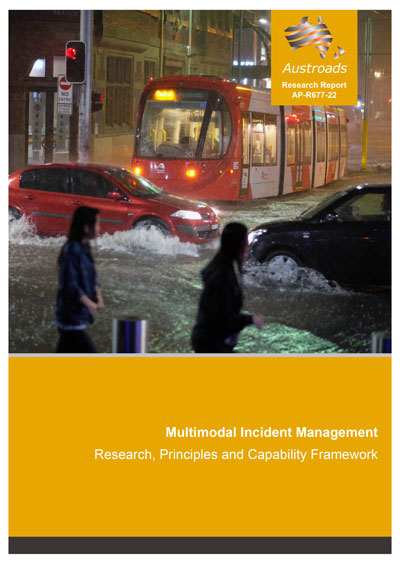Traffic Management

- Publication no: AP-R677-22
- ISBN: 978-1-922700-53-7
- Published: 11 August 2022
- PDF (free) Download
This report details research into the ways transport agencies manage unplanned incidents that impact the normal operation of more than one transport mode. It includes 10 guiding principles and a capability framework.
Road agencies need guidance on Multimodal Incident Management (MMIM) to help address their current and future transport needs. Through consultation with agency representatives, this report presents a commonly agreed definition of MMIM as the resolution of an unplanned incident that negatively impacts, or has the potential to impact, the normal operation of more than one transport mode. MMIM aims to maintain transport services and minimise journey disruptions in day-to-day transport operations.
In developing MMIM guidance, research included an international literature review and consultation with Austroads member agency MMIM practitioners. This research combined with author knowledge led to findings that were distilled into key themes that agencies should consider in planning and developing MMIM.
This report also presents a MMIM Capability Framework that can be used as a flexible tool by agencies to build their MMIM capability.
Austroads member agencies will benefit from adopting a harmonised definition and approach to developing MMIM. A consistent approach to business, information systems, technology, and architecture will promote multimodal interactions and interfaces between road and public transport operators, providing optimised incident management and traveller services.
Join us for a webinar on Tuesday 20 September 2022 for an overview of the multimodal incident management research findings and agency guidance.
No charge but registration is essential.
Can’t make the live session? Register and we’ll send you a link to the recording.
- Summary
- 1. Introduction
- 1.1 Purpose
- 1.2 Scope
- 1.3 Methodology
- 2. Existing Multimodal Incident Management Practices
- 2.1 International MMIM Practice
- 2.1.1 USA
- 2.1.2 Canada
- 2.1.3 United Kingdom
- 2.1.4 Hong Kong
- 2.1.5 Singapore
- 2.1.6 Seoul
- 2.1.7 France
- 2.1.8 Sweden
- 2.2 MMIM-related Architectures
- 2.2.1 USDOT ITS Reference Architecture
- 2.2.2 US Integration Corridor Management System Architecture
- 2.2.3 EU FRAME Reference Architecture
- 2.3 Australia and New Zealand Practices
- 2.3.1 Queensland Department of Transport and Main Roads
- 2.3.2 Transport for NSW
- 2.3.3 Victoria Department of Transport
- 2.3.4 South Australia Department for Infrastructure and Transport
- 2.3.5 Northern Territory Government
- 2.3.6 Main Roads Western Australia
- 2.3.7 Tasmania Department of State Growth
- 2.3.8 Waka Kotahi New Zealand Transport Agency
- 2.1 International MMIM Practice
- 3. Findings and Discussion
- 4. Multimodal Incident Management Themes
- 4.1 Vision and Strategy for MMIM
- 4.2 Coordination and Cooperation
- 4.3 Integrated Operations Centres
- 4.4 Leverage Existing Practices
- 4.5 Integrated Traveller Information
- 4.6 Travel Demand Management and Network Load Balancing
- 4.7 Alternative Transport Services
- 4.8 Multimodal Data Exchange
- 4.9 MMIM Tools
- 4.10 Intelligence and Decision Making
- 5. Principles for Successful MMIM
- 6. Multimodal Incident Management Capability Framework
- 6.1 MMIM Capability Maturity Model
- 6.1.1 Level 1 MMIM Capability Maturity No MMIM
- 6.1.2 Level 2 MMIM Capability Maturity – Emerging MMIM
- 6.1.3 Level 3 MMIM Capability Maturity – Established MMIM
- 6.1.4 Level 4 MMIM Capability Maturity – Integrated MMIM
- 6.1.5 Level 5 MMIM Capability Maturity – Optimised MMIM
- 6.2 MMIM Capabilities
- 6.2.1 Coordination and Cooperation
- 6.2.2 Incident Response Planning
- 6.2.3 Network Monitoring and Incident Detection
- 6.2.4 Incident Response Management
- 6.2.5 Operational Communications
- 6.2.6 Network Management
- 6.2.7 Travel Demand Management
- 6.2.8 Business Intelligence and Analytics
- 6.3 Agency Current State MMIM Capability
- 6.4 Guidance on How to Use the MMIM Capability Maturity Model
- 6.4.1 Determine Current State MMIM Capability
- 6.4.2 Determine Target State MMIM Capability
- 6.4.3 Gap Analysis
- 6.4.4 Develop the Roadmap
- 6.4.5 Plan and Deliver Changes
- 6.1 MMIM Capability Maturity Model
- References
